Zihao Sheng
VL-SAFE: Vision-Language Guided Safety-Aware Reinforcement Learning with World Models for Autonomous Driving
May 22, 2025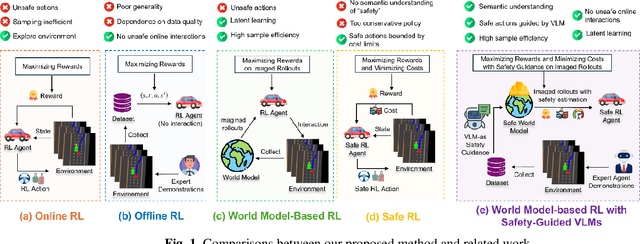

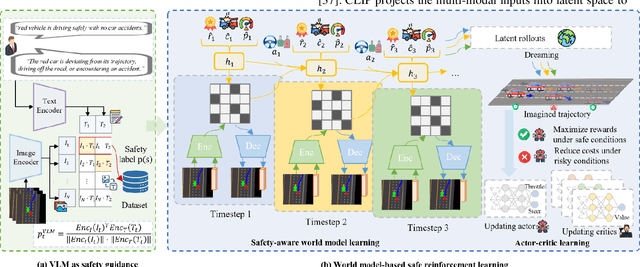
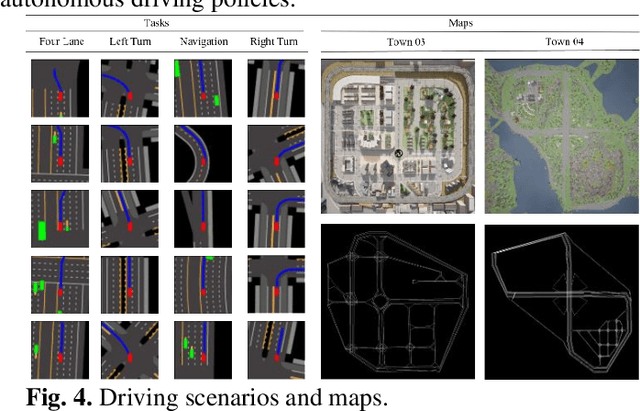
Abstract:Reinforcement learning (RL)-based autonomous driving policy learning faces critical limitations such as low sample efficiency and poor generalization; its reliance on online interactions and trial-and-error learning is especially unacceptable in safety-critical scenarios. Existing methods including safe RL often fail to capture the true semantic meaning of "safety" in complex driving contexts, leading to either overly conservative driving behavior or constraint violations. To address these challenges, we propose VL-SAFE, a world model-based safe RL framework with Vision-Language model (VLM)-as-safety-guidance paradigm, designed for offline safe policy learning. Specifically, we construct offline datasets containing data collected by expert agents and labeled with safety scores derived from VLMs. A world model is trained to generate imagined rollouts together with safety estimations, allowing the agent to perform safe planning without interacting with the real environment. Based on these imagined trajectories and safety evaluations, actor-critic learning is conducted under VLM-based safety guidance to optimize the driving policy more safely and efficiently. Extensive evaluations demonstrate that VL-SAFE achieves superior sample efficiency, generalization, safety, and overall performance compared to existing baselines. To the best of our knowledge, this is the first work that introduces a VLM-guided world model-based approach for safe autonomous driving. The demo video and code can be accessed at: https://ys-qu.github.io/vlsafe-website/
Sky-Drive: A Distributed Multi-Agent Simulation Platform for Socially-Aware and Human-AI Collaborative Future Transportation
Apr 25, 2025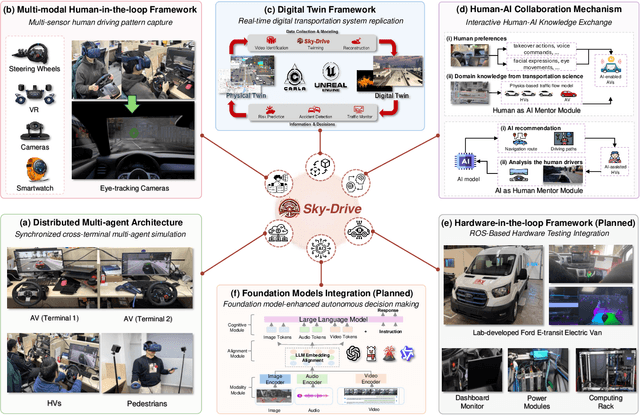
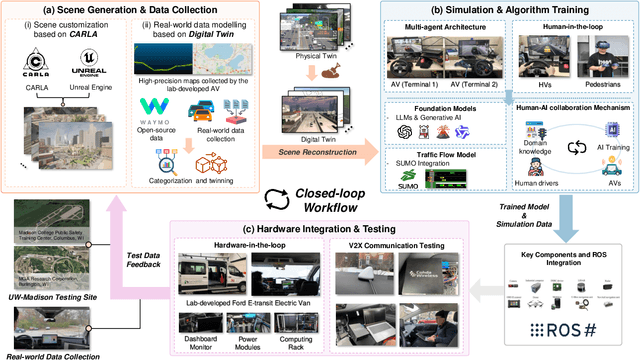
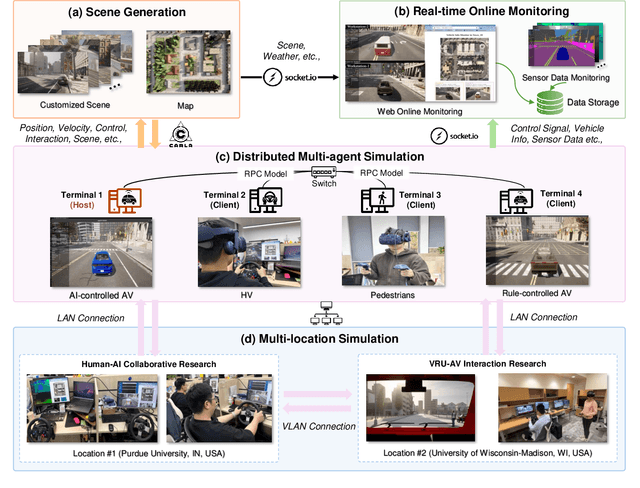
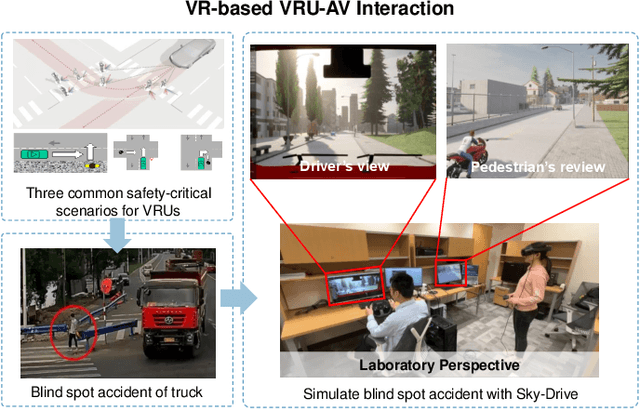
Abstract:Recent advances in autonomous system simulation platforms have significantly enhanced the safe and scalable testing of driving policies. However, existing simulators do not yet fully meet the needs of future transportation research, particularly in modeling socially-aware driving agents and enabling effective human-AI collaboration. This paper introduces Sky-Drive, a novel distributed multi-agent simulation platform that addresses these limitations through four key innovations: (a) a distributed architecture for synchronized simulation across multiple terminals; (b) a multi-modal human-in-the-loop framework integrating diverse sensors to collect rich behavioral data; (c) a human-AI collaboration mechanism supporting continuous and adaptive knowledge exchange; and (d) a digital twin (DT) framework for constructing high-fidelity virtual replicas of real-world transportation environments. Sky-Drive supports diverse applications such as autonomous vehicle (AV)-vulnerable road user (VRU) interaction modeling, human-in-the-loop training, socially-aware reinforcement learning, personalized driving policy, and customized scenario generation. Future extensions will incorporate foundation models for context-aware decision support and hardware-in-the-loop (HIL) testing for real-world validation. By bridging scenario generation, data collection, algorithm training, and hardware integration, Sky-Drive has the potential to become a foundational platform for the next generation of socially-aware and human-centered autonomous transportation research. The demo video and code are available at:https://sky-lab-uw.github.io/Sky-Drive-website/
CurricuVLM: Towards Safe Autonomous Driving via Personalized Safety-Critical Curriculum Learning with Vision-Language Models
Feb 21, 2025
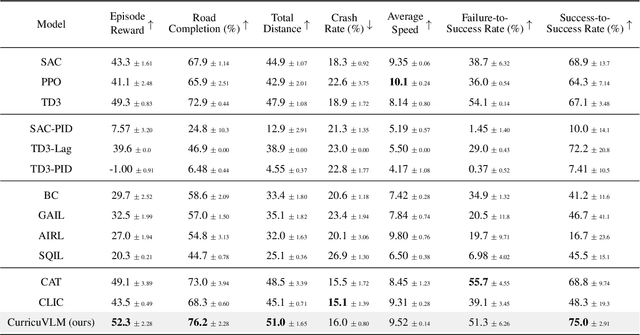
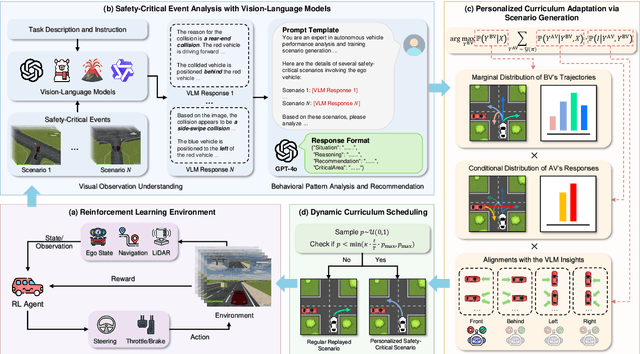
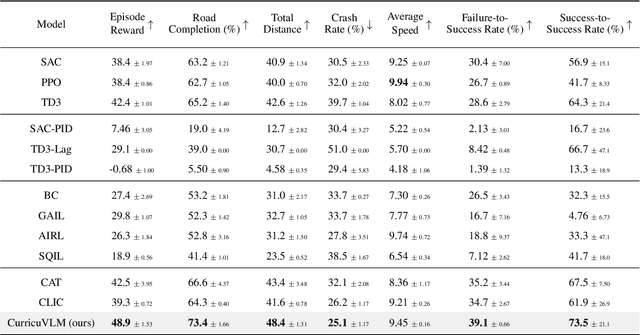
Abstract:Ensuring safety in autonomous driving systems remains a critical challenge, particularly in handling rare but potentially catastrophic safety-critical scenarios. While existing research has explored generating safety-critical scenarios for autonomous vehicle (AV) testing, there is limited work on effectively incorporating these scenarios into policy learning to enhance safety. Furthermore, developing training curricula that adapt to an AV's evolving behavioral patterns and performance bottlenecks remains largely unexplored. To address these challenges, we propose CurricuVLM, a novel framework that leverages Vision-Language Models (VLMs) to enable personalized curriculum learning for autonomous driving agents. Our approach uniquely exploits VLMs' multimodal understanding capabilities to analyze agent behavior, identify performance weaknesses, and dynamically generate tailored training scenarios for curriculum adaptation. Through comprehensive analysis of unsafe driving situations with narrative descriptions, CurricuVLM performs in-depth reasoning to evaluate the AV's capabilities and identify critical behavioral patterns. The framework then synthesizes customized training scenarios targeting these identified limitations, enabling effective and personalized curriculum learning. Extensive experiments on the Waymo Open Motion Dataset show that CurricuVLM outperforms state-of-the-art baselines across both regular and safety-critical scenarios, achieving superior performance in terms of navigation success, driving efficiency, and safety metrics. Further analysis reveals that CurricuVLM serves as a general approach that can be integrated with various RL algorithms to enhance autonomous driving systems. The code and demo video are available at: https://zihaosheng.github.io/CurricuVLM/.
VLM-RL: A Unified Vision Language Models and Reinforcement Learning Framework for Safe Autonomous Driving
Dec 20, 2024



Abstract:In recent years, reinforcement learning (RL)-based methods for learning driving policies have gained increasing attention in the autonomous driving community and have achieved remarkable progress in various driving scenarios. However, traditional RL approaches rely on manually engineered rewards, which require extensive human effort and often lack generalizability. To address these limitations, we propose \textbf{VLM-RL}, a unified framework that integrates pre-trained Vision-Language Models (VLMs) with RL to generate reward signals using image observation and natural language goals. The core of VLM-RL is the contrasting language goal (CLG)-as-reward paradigm, which uses positive and negative language goals to generate semantic rewards. We further introduce a hierarchical reward synthesis approach that combines CLG-based semantic rewards with vehicle state information, improving reward stability and offering a more comprehensive reward signal. Additionally, a batch-processing technique is employed to optimize computational efficiency during training. Extensive experiments in the CARLA simulator demonstrate that VLM-RL outperforms state-of-the-art baselines, achieving a 10.5\% reduction in collision rate, a 104.6\% increase in route completion rate, and robust generalization to unseen driving scenarios. Furthermore, VLM-RL can seamlessly integrate almost any standard RL algorithms, potentially revolutionizing the existing RL paradigm that relies on manual reward engineering and enabling continuous performance improvements. The demo video and code can be accessed at: https://zilin-huang.github.io/VLM-RL-website.
Towards 3D Semantic Scene Completion for Autonomous Driving: A Meta-Learning Framework Empowered by Deformable Large-Kernel Attention and Mamba Model
Nov 06, 2024Abstract:Semantic scene completion (SSC) is essential for achieving comprehensive perception in autonomous driving systems. However, existing SSC methods often overlook the high deployment costs in real-world applications. Traditional architectures, such as 3D Convolutional Neural Networks (3D CNNs) and self-attention mechanisms, face challenges in efficiently capturing long-range dependencies within 3D voxel grids, limiting their effectiveness. To address these issues, we introduce MetaSSC, a novel meta-learning-based framework for SSC that leverages deformable convolution, large-kernel attention, and the Mamba (D-LKA-M) model. Our approach begins with a voxel-based semantic segmentation (SS) pretraining task, aimed at exploring the semantics and geometry of incomplete regions while acquiring transferable meta-knowledge. Using simulated cooperative perception datasets, we supervise the perception training of a single vehicle using aggregated sensor data from multiple nearby connected autonomous vehicles (CAVs), generating richer and more comprehensive labels. This meta-knowledge is then adapted to the target domain through a dual-phase training strategy that does not add extra model parameters, enabling efficient deployment. To further enhance the model's capability in capturing long-sequence relationships within 3D voxel grids, we integrate Mamba blocks with deformable convolution and large-kernel attention into the backbone network. Extensive experiments demonstrate that MetaSSC achieves state-of-the-art performance, significantly outperforming competing models while also reducing deployment costs.
Trustworthy Human-AI Collaboration: Reinforcement Learning with Human Feedback and Physics Knowledge for Safe Autonomous Driving
Sep 01, 2024Abstract:In the field of autonomous driving, developing safe and trustworthy autonomous driving policies remains a significant challenge. Recently, Reinforcement Learning with Human Feedback (RLHF) has attracted substantial attention due to its potential to enhance training safety and sampling efficiency. Nevertheless, existing RLHF-enabled methods often falter when faced with imperfect human demonstrations, potentially leading to training oscillations or even worse performance than rule-based approaches. Inspired by the human learning process, we propose Physics-enhanced Reinforcement Learning with Human Feedback (PE-RLHF). This novel framework synergistically integrates human feedback (e.g., human intervention and demonstration) and physics knowledge (e.g., traffic flow model) into the training loop of reinforcement learning. The key advantage of PE-RLHF is its guarantee that the learned policy will perform at least as well as the given physics-based policy, even when human feedback quality deteriorates, thus ensuring trustworthy safety improvements. PE-RLHF introduces a Physics-enhanced Human-AI (PE-HAI) collaborative paradigm for dynamic action selection between human and physics-based actions, employs a reward-free approach with a proxy value function to capture human preferences, and incorporates a minimal intervention mechanism to reduce the cognitive load on human mentors. Extensive experiments across diverse driving scenarios demonstrate that PE-RLHF significantly outperforms traditional methods, achieving state-of-the-art (SOTA) performance in safety, efficiency, and generalizability, even with varying quality of human feedback. The philosophy behind PE-RLHF not only advances autonomous driving technology but can also offer valuable insights for other safety-critical domains. Demo video and code are available at: \https://zilin-huang.github.io/PE-RLHF-website/
Traffic expertise meets residual RL: Knowledge-informed model-based residual reinforcement learning for CAV trajectory control
Aug 30, 2024Abstract:Model-based reinforcement learning (RL) is anticipated to exhibit higher sample efficiency compared to model-free RL by utilizing a virtual environment model. However, it is challenging to obtain sufficiently accurate representations of the environmental dynamics due to uncertainties in complex systems and environments. An inaccurate environment model may degrade the sample efficiency and performance of model-based RL. Furthermore, while model-based RL can improve sample efficiency, it often still requires substantial training time to learn from scratch, potentially limiting its advantages over model-free approaches. To address these challenges, this paper introduces a knowledge-informed model-based residual reinforcement learning framework aimed at enhancing learning efficiency by infusing established expert knowledge into the learning process and avoiding the issue of beginning from zero. Our approach integrates traffic expert knowledge into a virtual environment model, employing the Intelligent Driver Model (IDM) for basic dynamics and neural networks for residual dynamics, thus ensuring adaptability to complex scenarios. We propose a novel strategy that combines traditional control methods with residual RL, facilitating efficient learning and policy optimization without the need to learn from scratch. The proposed approach is applied to CAV trajectory control tasks for the dissipation of stop-and-go waves in mixed traffic flow. Experimental results demonstrate that our proposed approach enables the CAV agent to achieve superior performance in trajectory control compared to the baseline agents in terms of sample efficiency, traffic flow smoothness and traffic mobility. The source code and supplementary materials are available at https://github.com/zihaosheng/traffic-expertise-RL/.
Human as AI Mentor: Enhanced Human-in-the-loop Reinforcement Learning for Safe and Efficient Autonomous Driving
Jan 10, 2024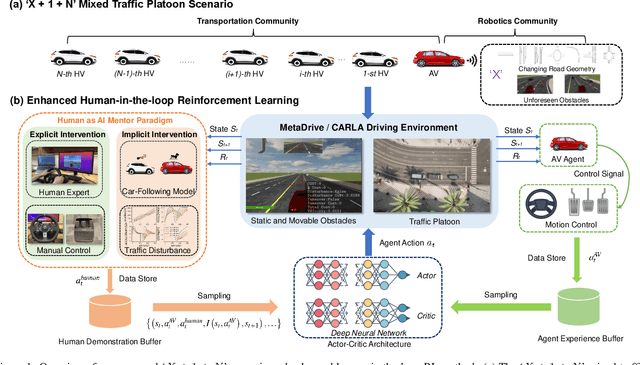
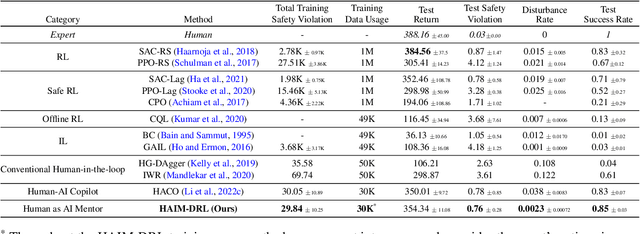
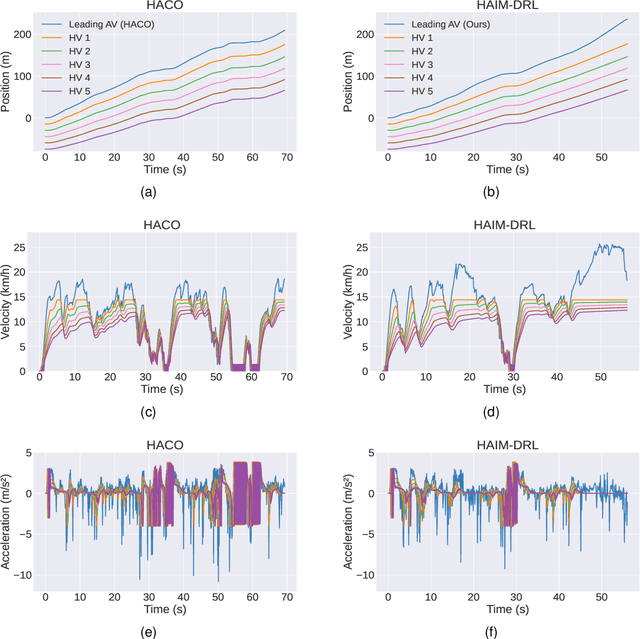

Abstract:Despite significant progress in autonomous vehicles (AVs), the development of driving policies that ensure both the safety of AVs and traffic flow efficiency has not yet been fully explored. In this paper, we propose an enhanced human-in-the-loop reinforcement learning method, termed the Human as AI mentor-based deep reinforcement learning (HAIM-DRL) framework, which facilitates safe and efficient autonomous driving in mixed traffic platoon. Drawing inspiration from the human learning process, we first introduce an innovative learning paradigm that effectively injects human intelligence into AI, termed Human as AI mentor (HAIM). In this paradigm, the human expert serves as a mentor to the AI agent. While allowing the agent to sufficiently explore uncertain environments, the human expert can take control in dangerous situations and demonstrate correct actions to avoid potential accidents. On the other hand, the agent could be guided to minimize traffic flow disturbance, thereby optimizing traffic flow efficiency. In detail, HAIM-DRL leverages data collected from free exploration and partial human demonstrations as its two training sources. Remarkably, we circumvent the intricate process of manually designing reward functions; instead, we directly derive proxy state-action values from partial human demonstrations to guide the agents' policy learning. Additionally, we employ a minimal intervention technique to reduce the human mentor's cognitive load. Comparative results show that HAIM-DRL outperforms traditional methods in driving safety, sampling efficiency, mitigation of traffic flow disturbance, and generalizability to unseen traffic scenarios. The code and demo videos for this paper can be accessed at: https://zilin-huang.github.io/HAIM-DRL-website/
A Physics Enhanced Residual Learning (PERL) Framework for Traffic State Prediction
Sep 26, 2023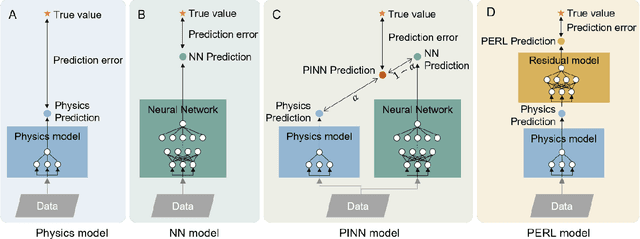
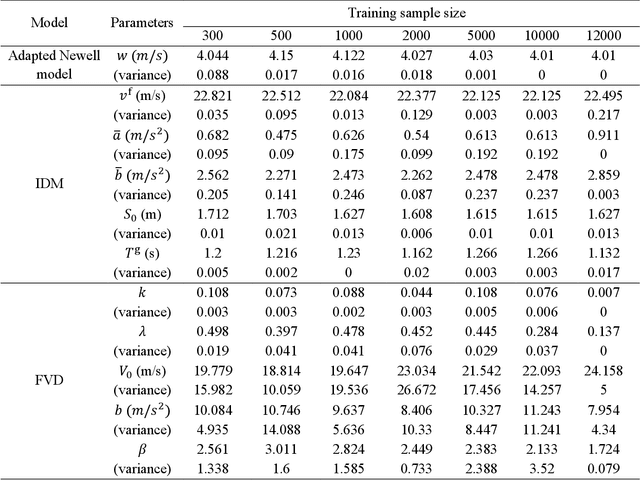

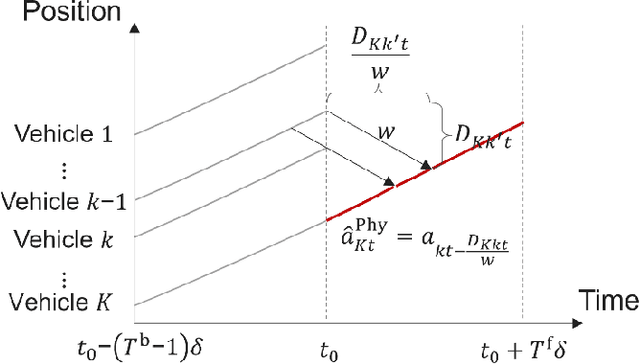
Abstract:In vehicle trajectory prediction, physics models and data-driven models are two predominant methodologies. However, each approach presents its own set of challenges: physics models fall short in predictability, while data-driven models lack interpretability. Addressing these identified shortcomings, this paper proposes a novel framework, the Physics-Enhanced Residual Learning (PERL) model. PERL integrates the strengths of physics-based and data-driven methods for traffic state prediction. PERL contains a physics model and a residual learning model. Its prediction is the sum of the physics model result and a predicted residual as a correction to it. It preserves the interpretability inherent to physics-based models and has reduced data requirements compared to data-driven methods. Experiments were conducted using a real-world vehicle trajectory dataset. We proposed a PERL model, with the Intelligent Driver Model (IDM) as its physics car-following model and Long Short-Term Memory (LSTM) as its residual learning model. We compare this PERL model with the physics car-following model, data-driven model, and other physics-informed neural network (PINN) models. The result reveals that PERL achieves better prediction with a small dataset, compared to the physics model, data-driven model, and PINN model. Second, the PERL model showed faster convergence during training, offering comparable performance with fewer training samples than the data-driven model and PINN model. Sensitivity analysis also proves comparable performance of PERL using another residual learning model and a physics car-following model.
CV2X-LOCA: Roadside Unit-Enabled Cooperative Localization Framework for Autonomous Vehicles
Apr 03, 2023



Abstract:An accurate and robust localization system is crucial for autonomous vehicles (AVs) to enable safe driving in urban scenes. While existing global navigation satellite system (GNSS)-based methods are effective at locating vehicles in open-sky regions, achieving high-accuracy positioning in urban canyons such as lower layers of multi-layer bridges, streets beside tall buildings, tunnels, etc., remains a challenge. In this paper, we investigate the potential of cellular-vehicle-to-everything (C-V2X) wireless communications in improving the localization performance of AVs under GNSS-denied environments. Specifically, we propose the first roadside unit (RSU)-enabled cooperative localization framework, namely CV2X-LOCA, that only uses C-V2X channel state information to achieve lane-level positioning accuracy. CV2X-LOCA consists of four key parts: data processing module, coarse positioning module, environment parameter correcting module, and vehicle trajectory filtering module. These modules jointly handle challenges present in dynamic C-V2X networks. Extensive simulation and field experiments show that CV2X-LOCA achieves state-of-the-art performance for vehicle localization even under noisy conditions with high-speed movement and sparse RSUs coverage environments. The study results also provide insights into future investment decisions for transportation agencies regarding deploying RSUs cost-effectively.
 Add to Chrome
Add to Chrome Add to Firefox
Add to Firefox Add to Edge
Add to Edge